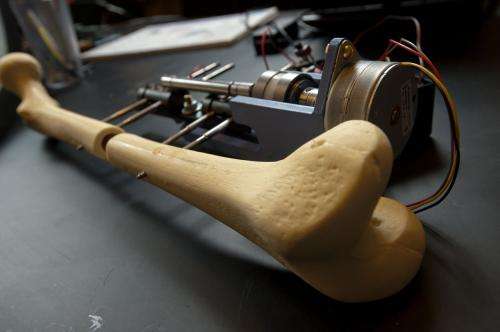Student engineers automate limb lengthening for kids

Another day, another four turns of the screw. That's just a part of life for people, primarily children, undergoing the long and difficult process of distraction osteogenesis, a method to correct bone deformities that leave one limb shorter than the other.
A team of Rice University undergraduates has invented a device they hope will make the process safer and easier.
In collaboration with Shriners Hospital for Children in Houston, the students came up with "LinDi," a self-adjusting, automated linear distractor. It eliminates manual manipulation of the screw with a motorized process that makes the gradual growth of new bone a more natural process. And for the first time in such a device, they have built in a force-feedback loop that protects fragile tissues and nerves from being overstressed.
To correct deformities suffered by as many as 10 million children due to trauma, infection or congenital causes, surgeons break a bone and apply a distractor that stretches the bone as it heals and gently nudges the arm or leg to a more appropriate length.
The distractor incorporates long pins sunk right into the bone on either side of the surgical break. As the bone heals, but before it sets, the patient uses an Allen wrench to give the drive screw a quarter turn four times a day and push the pins further apart a tiny bit at a time.
That's inconvenient, even risky if a child or parent forgets to make the adjustment, said Rice mechanical engineering student Raquel Kahn. And wearing the bulky brace is no treat, either.
Team members Kahn, Alvin Chou, Mario Gonzalez, Stephanie Herkes and Elaine Wong took LinDi on as their senior design capstone project at the behest of Gloria Gogola, an orthopedic hand and upper-extremity surgeon at Shriners who specializes in pediatrics.
"The process of limb lengthening -- essentially creating a localized mini-growth spurt -- works well for bones, but is very hard on the soft tissues such as nerves and blood vessels," Gogola said. "This team has done an outstanding job of designing a creative solution. Their device not only protects the soft tissues, it will ultimately speed up the entire process."
"The problem with the current device is that there's a lot of room for error," Kahn said. "You can imagine that one might forget to turn it once, or turn it the wrong way, or turn it too much. And a lot of problems can arise in the soft tissue and the nerves surrounding the bone. That's the limiting factor of this process. But LinDi implements a motor to make the distraction process nearly continuous."
Kahn said the motorized, battery-operated LinDi adjusts the device almost 1,000 times every day, "so the process is more gradual and continuous, similar to actual bone growth."
Working at Rice's Oshman Engineering Design Kitchen (OEDK), the students had access to all the materials and expertise they needed to conceptualize, build and test a prototype even while completing their coursework. "We're teaching students the importance of prototyping as early as possible," said Marcia O'Malley, an associate professor of mechanical engineering and materials science and the team's faculty adviser. "Even if it's cardboard and tape, they're able to visualize a project early in the process.
"One of the big features of this project is the force sensor," she said. "If the loads on the tissue are too high, the device shuts the motor off." O'Malley said early tests with strain gauges paid off in the team's level of confidence when the time came to build a working prototype. "The great thing about the OEDK is that everything is so accessible here. I could say, 'Well, that team over there is working with strain gauges. Go talk to them and find out how they're doing it," she said.
Current patients wear distractors for as long as it takes to complete the process, typically stretching a limb for two to four months, Kahn said. Then they leave the device on for six more weeks, like a cast, while the bone sets. Each of the Rice students wore a standard distractor (minus the bone-drilling part) for 24 hours to get a feel for what patients endure. "The hardest part was we kept banging into things," Gonzalez said.
But through interviews with Gogola's patients, they learned how tough children are. "We were really concerned, because it looks like a pretty scary, uncomfortable process," Herkes said. "It looks like a torture device. We asked one little boy who had it on his humerus his No. 1 complaint and he said, 'My school uniform is red, and it doesn't match.'"
Through Shriners, the team got the opportunity to perform short-term animal testing that "helped us work out some of the kinks we weren't aware of in the device," Herkes said.
"We've gotten some nice results," Kahn added. "Our device is doing what we want it to do."
Though the students are about to graduate, they expect another team to continue development of the LinDi. One goal will be to make the device less bulky, and therefore curtail wear and tear on both the distractor and the patient.

















